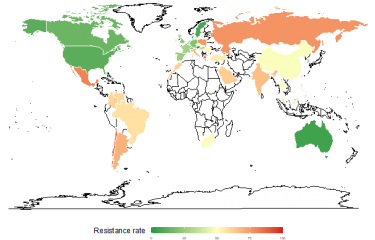Scientists from the Institut Pasteur have developed an approach inspired by evolutionary biology for more precise identification of the starting point of potential bacterial disease outbreaks.
Identifying the pathogens responsible for a disease outbreak can be a complicated task. From one generation to the next, each pathogen can mutate, and it can soon become difficult to identify the common ancestry of a group of strains.
Scientists from the Institut Pasteur have used tools usually employed in evolutionary biology to help mitigate this problem. "With our mathematical model which simulates the evolution of pathogenic bacteria with a single defined origin, we offer the possibility of estimating the duration of outbreaks based on genetic data from pathogens isolated in the field," explains Sylvain Brisse, Head of the Biodiversity and Epidemiology of Bacterial Pathogens Unit at the Institut Pasteur.
By modeling the mutation rate of a pathogen over time, the scientists are able to situate a specimen of the same pathogen in the timeline of an outbreak. This modeling and comparison work may ultimately help pinpoint the original strain responsible and therefore curb the outbreak.
It was previously standard practice to randomly estimate a mutation rate beyond which one strain of a given pathogen was considered as having no link with other strains. With the new model, these uncertainties can now be reduced. "This should be useful in providing a credible time window for epidemiological research aimed at identifying and eliminating sources of infection," confirms Lulla Opatowski, a scientist in the Institut Pasteur's Epidemiology and Modeling of Bacterial Escape to Antimicrobials Unit.
This study comes under the Emerging Infectious Diseases priority scientific area in the Institut Pasteur's 2019-2023 Strategic Plan.
Source
Defining genomic epidemiology thresholds for common-source bacterial outbreaks: a modelling study - The Lancet Microbe
Published:March 29, 2023. DOI:https://doi.org/10.1016/S2666-5247(22)00380-9
Audrey Duval1, Lulla Opatowski2, Sylvain Brisse3
- Epidemiology and Modelling of Bacterial Escape to Antimicrobials Laboratory, Institut Pasteur, Université Paris Cité, Paris, France
- Anti-infective Evasion and Pharmacoepidemiology Team, CESP, Université Paris-Saclay, UVSQ, INSERM U1018, Montigny-le-Bretonneux, France
- Institut Pasteur, Université Paris Cité, Biodiversity and Epidemiology of Bacterial Pathogens, Paris, France






